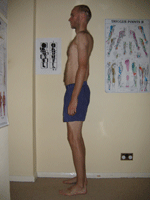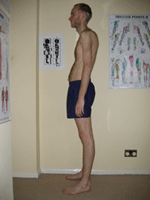Rolfing Case Study
Nick Nielsen Case Study

After

Before
Nick’s Account
I started Rolfing® structural integration with Alan Richardson early in 2006. I knew very little about the practice and was recommended it by a good friend who had received treatment in Cape Town, South Africa. I was interested in the benefits from both a physical and emotional perspective, having heard that the structural re-integration could free up blockages of varying types in the body. Before the Rolfing, I was in good physical shape but was aware that my posture and the way I held my body probably wasn’t as good as it could have been. I had no idea, however, about the dramatic extent of improvement I was going to experience.
The treatment itself was in the main a relaxing and enjoyable affair. 10 minutes of the hour session could probably be described as uncomfortable as Alan worked on particular areas of tension in my body. The areas of particular discomfort in my body were my inner thighs and chest, because of the amount of change they would need to go through to re-support the new structure of my whole body. One of the most amazing experiences I had during my Rolfing was the almost instantaneous change I could feel in my whole body after Alan had worked on a particular area. I would get up from the table and experience a more stable feeling in my legs which totally changed the way I stand.
With my Rolfing Series now complete, I realise I benefited much more and in different ways than I had initially expected. My posture is now better and my overall structure is far straighter and feels more healthy. I would not have predicted however the benefits I experience in terms of ‘feeling’ in my body. I am able to hold physical space in a more powerful way and as a result I feel more confident and lighter in my attitude.
I would definitely recommend Rolfing with Alan and have already done so a number of times. Having seen the changes in me, both my partner and father are interested. For someone who spends a lot of time in his head, like myself, it’s easy to forget the vital function the body plays in anchoring us to life and how we experience it. Rolfing has enabled me to gain this whole new understanding for which I am very grateful.
Rolfer’s Account
Before Rolfing – postural issues
1. The knees are habitually locked back, causing the lower legs to land behind the thighs.
2. The pelvis is anteriorly tilted, meaning the pubic bone tilts towards the ground and the coccyx arcs upwards. The pelvis is also shifted forward of the midline.
3. The stomach and lower back are out of balance, with the abdomen spilling forward and the curve of the lower back being exaggerated by the pelvic tilt.
4. The chest is collapsed down towards the hips.
5. There is an exaggerated kyphosis in the upper back.
6. The shoulders are slumped forward.
7. The neck is angled forward, mirroring the anterior pelvic tilt. The exaggerated curve of the back of the neck mirrors that of the lower back.
8. The head is tilted back at the point where the highest cervical vertebra meets the base of the skull (the A-O joint). This is compensating for the forward tilt of the neck.
Rolfing procedure
Before Rolfing, gravity is clearly getting the better of Nick, causing a slumping posture with strain in the body’s joints and muscles. The general appearance is of energy bound up in muscular tightness. Nick’s muscles are working too hard to hold up his body against the force of gravity. Movement potential is lost because of the demands placed on muscles to maintain the bones in positions that are out of balance. The general aim of the Rolfing Series is to realign the body by treating the myofascial system – namely muscles, their fascial wrappings and the attachment points of muscles to bones. In areas of special tension the fascia is usually thick, cold and hard and acts as a kind of straight jacket for the enclosed muscles. Precise Rolfing intervention acts on the fascia to make it relatively thin, warm and soft, thus enabling muscles and joints to move more freely. Space is created and debilitating compressive tensions tend to transform into supportive reciprocal tensions similar to the guy wires for a tent.
Nick’s Ten Series
Even though some muscular groups were found to be weak and long, the emphasis was on releasing tightened muscles, rather than working to increase the tone of weak muscles. For example, in Nick’s head forward pattern the pectoral, sternocleidomastoid, levator scapula and upper trapezius muscles were tight and short. As these muscles were released through Rolfing, the long weakened rhomboids, serratus anterior and lower- and mid-trapezius ceased to be inhibited and became stronger through normal usage.
Initially there was abnormal tension in the inside of the upper legs. This was part of a tensional strain running from the inside thighs, through the pelvis, respiratory diaphragm and up into the front of the neck and jaw. This was addressed by organising first the feet and then the rest of the legs in order to create a strong basis of support for the pelvis and upper body. The feet, and front, back, inside and outside of the legs were systematically treated in order to release obvious tensions and create span and space. It was particularly significant to get the quadratus lumborum muscle to relax. This muscle connects the lowest rib to the crest of the hips, and in Nick’s case was chronically tight, having the effect of pulling the whole ribcage down towards the hips and exacerbating the slumping posture.
The first six sessions worked all the main muscles connecting lower and upper body to the hips, including hamstrings, quadriceps, adductors, abdominals and lower back muscles. By this stage the legs were much better balanced and able to act as a solid support for the pelvis and thorax. The pelvic tilt was reduced and there was visibly more space between the pelvis and the ribcage. Sessions seven and nine were very important as they dealt with the neck and shoulder girdle. By the end of session nine the ankles, knees, hips, shoulders and head were in fairly good alignment.
Nick took two vacations. There was a month break between sessions four and five, and a five-week break between sessions eight and nine. To compensate for these disruptions, we agreed to do an extra session. This final session took place almost two months after the tenth session and was probably more effective because of the extra time available for Nick to process the previous ten sessions.
The final session focused on deep restrictions in the ribs, diaphragm and thoracic viscera. Organisation of these areas considerably helped produce the visible balance between the front and back of Nick’s body, and helped the lift and take up more space. This in turn enabled the hand neck to sit much more comfortably on the thorax.
After Rolfing
All of the postural issues outlined above have been adequately improved. Nick appears to be more effectively fulfilling his physical potential, Muscle tone and joint alignment are better. Nick seems to be owning his space better – this is especially visible in the upper body, where Nick presents as more powerful and physically confident, Nick should continue to process the Series over the next few months, and has been advised to return for a three-session tune-up after six months. This is to ensure that development is proceeding on the right lines, deal with any intervening issues and take integration to the next level.
Alan Richardson
Tel 07957 307 616
www.rolfing-london.co.uk

